Tuna Carpaccio
This post may contain affiliate links. See my disclosure policy.
My easy and authentic tuna carpaccio recipe features thin slices of ahi tuna dressed simply with tangy capers, peppery red onion, and a drizzle of extra virgin olive oil. It’s healthy and fresh, elegant, and always impresses.
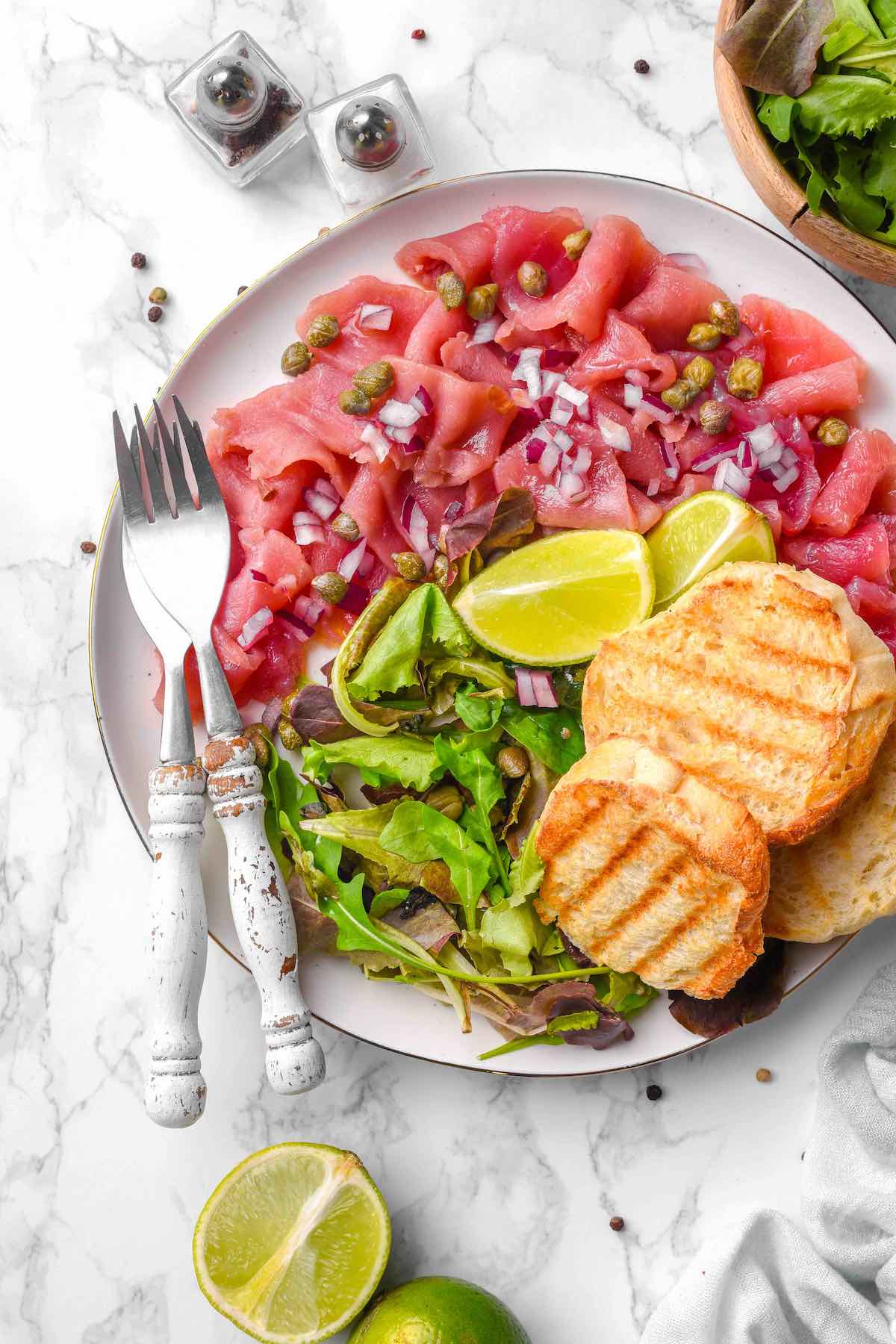
Tuna appetizers like ahi tuna and tuna tartare are always winners whenever I’m hosting or having a dinner party, but my tuna carpaccio recipe always leaves everyone in awe. It’s effortless to make and always one to impress.
I first learned to make this tuna carpaccio in culinary school, when we spent a semester on curing and raw proteins. With elegant and rich cuts like ahi tuna, the trick is not to douse it in heavy sauces or seasonings to detract from the natural flavor of the fish. I’ve been making this appetizer for over ten years now, and my seasoning mix hasn’t changed: It’s simple, with red onion, capers, a squeeze of citrus, and a drizzle of extra virgin olive oil to tie things up.
What is carpaccio?
Carpaccio is a classic Italian dish made with paper-thin slices of raw protein, traditionally beef, dressed simply with fresh, vibrant ingredients like citrus, olive oil, red onion, and sometimes arugula. Raw tuna works beautifully in the same style- its rich, meaty flavor and buttery-soft texture make it perfect for a light yet elegant carpaccio.
Why I love this recipe
- No fishy flavor. It may sound surprising, but raw ahi tuna isn’t fishy-tasting at all!
- No marinating needed. Hello, quick and easy appetizer! The prep time is fast, and there’s no need to marinate the fish ahead of time.
- Restaurant style for a fraction of the price.
Key Ingredients
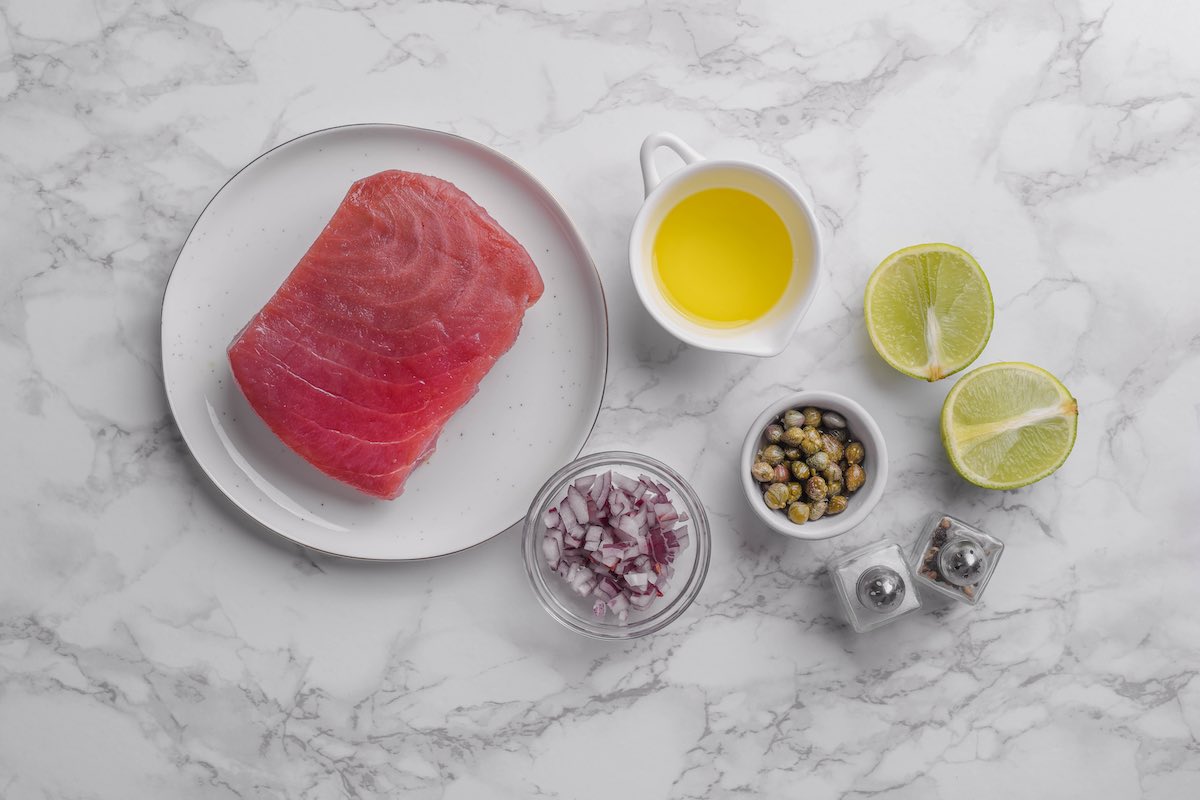
Find the printable recipe with measurements below.
- Ahi tuna steak. I recommend picking up high-quality sushi-grade ahi tuna steaks, AKA yellow-fin tuna. They’re not only safer to eat but will also make your dish incredibly delicious. Look for firm, vibrant steaks with a glossy appearance and a clean ocean-like aroma (avoid steaks that smell fishy or sour). If you can’t find ahi tuna, saku tuna, yellowfin tuna, or albacore tuna will work, too.
- Sea salt and pepper. To season the fish.
- Red onion. I prefer raw red onion because its zesty crunch has a nice contrast next to the delicate, tender tuna. Feel free to use sliced shallots or scallions for a milder option.
- Capers. For a burst of tangy, briny flavor.
- Olive oil. I like drizzling extra virgin olive oil over the fish. It adds a rich, almost buttery texture that’s unmatched! Avocado oil and sesame oil also work, but the taste won’t be the same.
- Lemon juice. The citrusy acidity brightens and enhances the overall flavor of the dish. I recommend using freshly squeezed lemon juice here, not the bottled stuff. Lime juice works well, too.
- Lime wedges. I like serving lime wedges on the side when I need an extra drizzle of fresh citrus juice. Feel free to serve yours with lemon wedges if you want.
Recipe variations
- More topping ideas. Mix and match the toppings as much as you like! Sometimes, I’ll add finely grated lemon or lime zest on top, as well as fresh chives, parsley, basil, or cilantro. Sliced fennel, olives, pine nuts, and celery are also delicious and add more texture. I’ll even add wasabi or diced chilies when I want a little spice!
- Drizzle more sauces on top. Experiment with the flavors by drizzling umami-forward sauces on top, like soy sauce, ponzu, tempura sauce, potsticker sauce, chili oil, or a simple balsamic vinegar reduction. They can also be served on the side for dipping.
How to make tuna carpaccio

Step 1 – Slice the tuna. Using a very sharp knife, slice the tuna steak into paper-thin slices.
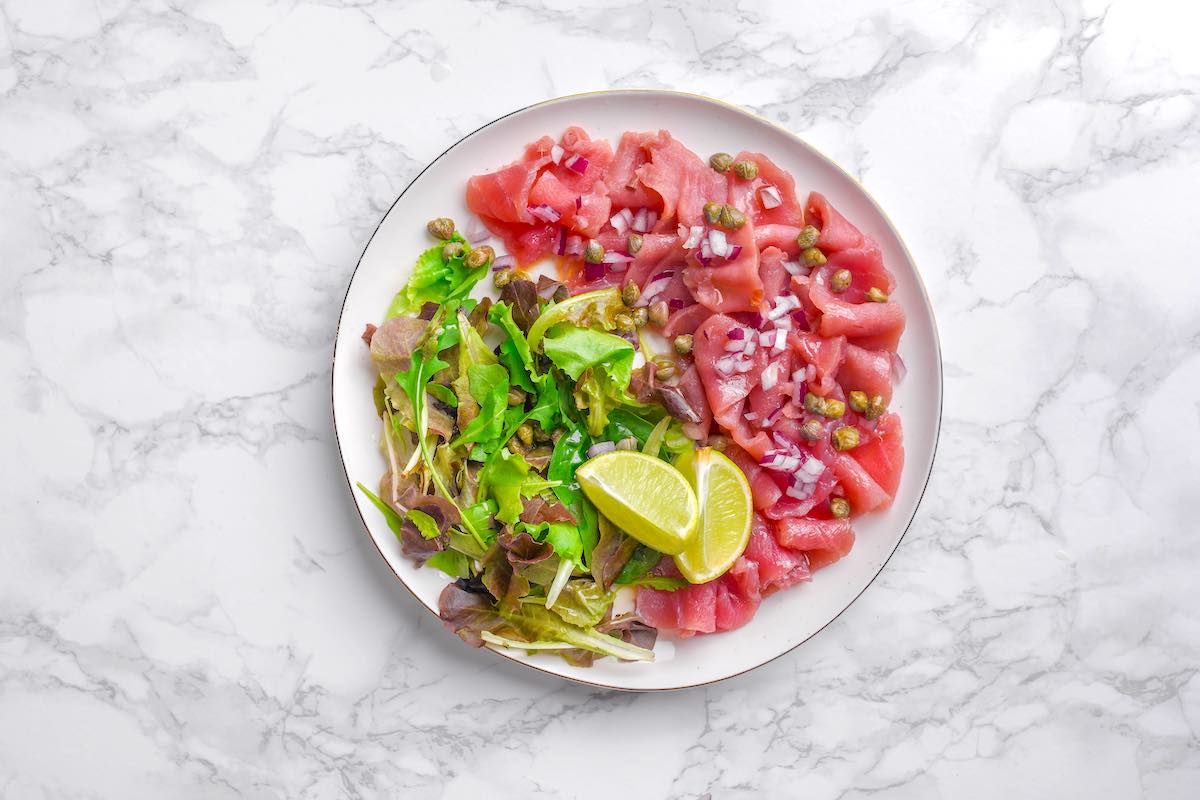
Step 2 – Assemble. Arrange the slices on a serving platter and season them with salt and pepper. Top the fish with red onion, capers, olive oil, and a drizzle of fresh lemon juice.
My recipe tips for success
Sushi-grade tuna is not a cheap protein, so I want you to make this successfully the first time and every time. Here are my pro tips:
- Freeze the tuna before slicing. In culinary school, we were taught that keeping proteins ice-cold makes them safer to work with and easier to cut paper-thin. I recommend partially freezing the tuna steak for 1-2 hours before slicing. The cold temperatures help firm up the flesh, making it easier to cut without the meat tearing or falling apart.
- Use a sharp knife. I can’t stress this enough: use your sharpest chef’s knife to slice the fish! You want the thinnest, most even pieces for a consistent texture and elegant presentation, and that can only be done with a sharp knife. I swear by my Yanagiba and sujihiki sashimi knives.
- Is raw red onion too strong for you? A handy trick I learned is to first soak the sliced onion in a bowl of cold water for 10 to 20 minutes. This helps tone down the sharp flavors, making the onion much more pleasant to eat.
- Serve it ASAP. If you can, serve the tuna carpaccio immediately after assembling. I find that this is the best way to experience its delicate textures and flavors.
Frequently asked questions
I prefer to make carpaccio with fresh tuna, but high-quality frozen tuna steaks also work. Please make sure it is from a reputable source and sashimi-grade. I made this with Costco frozen tuna steaks, and it turned out well.
Yes, raw tuna is safe to eat as long as it’s high quality and labeled sashimi or sushi-grade. This means it’s been handled and appropriately frozen to kill parasites. Always buy from a fishmonger or Japanese grocer, and keep the tuna very cold until serving.
The main difference is the cut and presentation. Carpaccio is paper-thin slices served simply with olive oil and citrus, while crude uses thicker cuts of raw fish or seafood, often paired with sauces and more varied seasonings.
I do not recommend freezing tuna carpaccio as it can negatively affect the quality and texture during thawing.
What to serve with this
The buttery slices of tuna are delicious all on their own! I’ll serve the tuna with fresh arugula and toasted baguette slices when I want to take it up a notch. I’ve also added them on top of my tuna poke bowls.
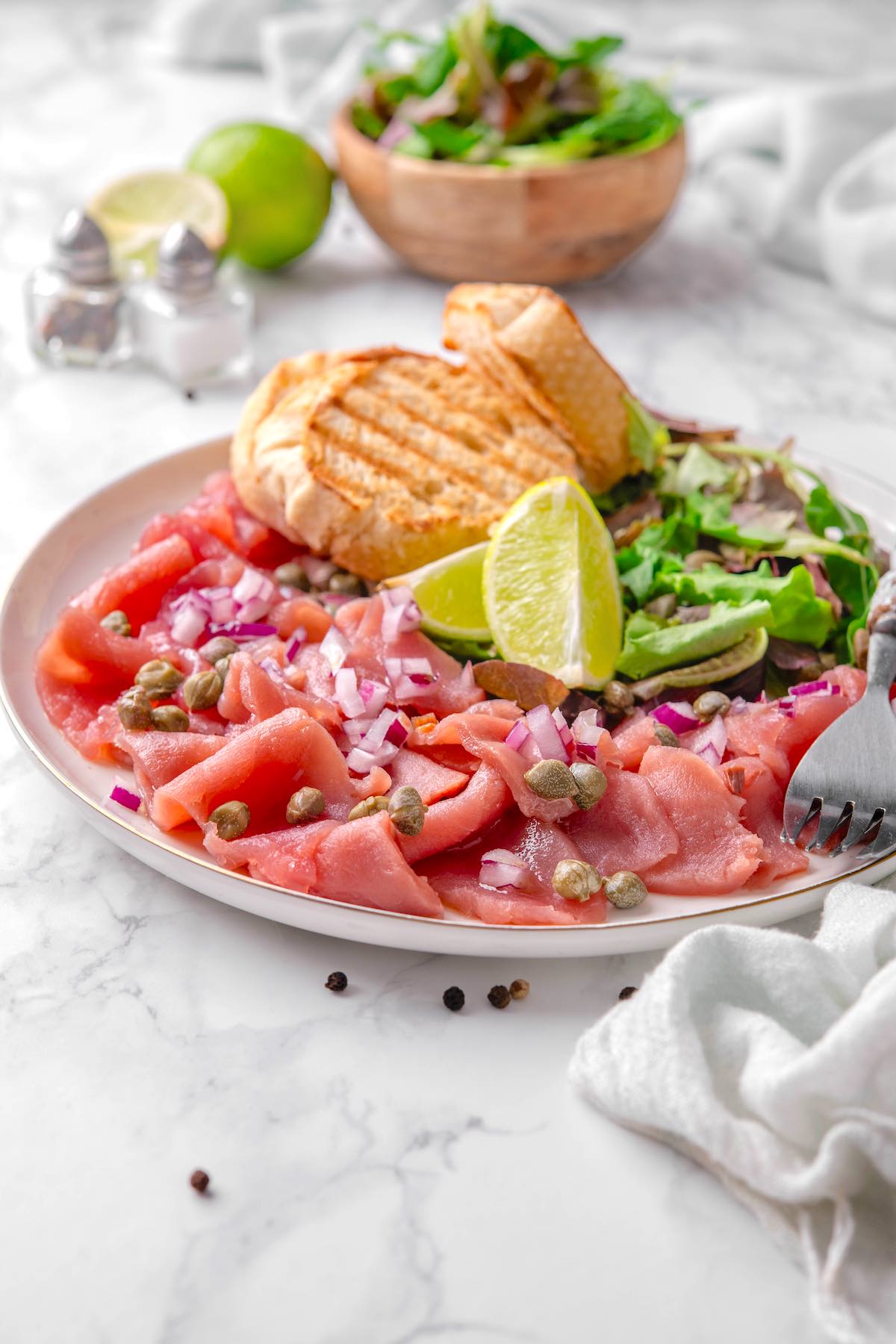
Storage and make ahead
To store: Wrap the leftover tuna slices tightly in plastic wrap and store them in an airtight container in the refrigerator. Enjoy the leftovers within 24 hours.
Make ahead: Save time before the party or gathering by slicing and arranging the sushi-grade tuna on your serving plate up to 5 hours in advance. Cover with a sheet of plastic wrap and keep it in the fridge. Tuna carpaccio can be fully assembled 2 to 3 hours in advance. Just keep it covered and in the refrigerator before serving. DO NOT drizzle the lemon/lime juice on top until right before serving. Otherwise, the acid will cook the fish.
More seafood appetizers
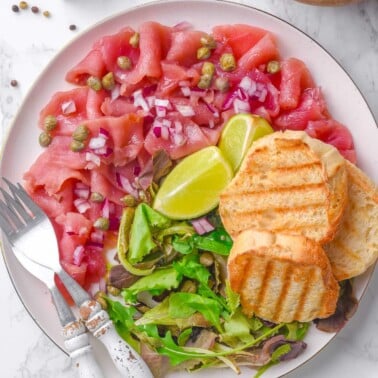
Tuna Carpaccio
Video
Ingredients
- 3/4 pounds ahi tuna steak raw
- 1/4 teaspoon salt
- 1/4 teaspoon pepper
- 1/4 small red onion finely diced
- 1/2 cup olive oil
- 1 small lime cut into wedges
- 2 tablespoons capers
Instructions
- With a very sharp knife, slice tuna into paper-thin slices. Ensure your cuts are secure and complete the cut in one move, to prevent them from breaking or tearing.
- Arrange the tuna slices onto the plate and season them with salt and pepper.
- Top the tuna with red onion, capers, and olive oil, and drizzle over some lemon juice. Serve the carpaccio with the rest of the lime wedges.
Notes
- Partially freeze the tuna: I recommend freezing the tuna for 1-2 hours beforehand to make slicing the tuna easier.
- Frozen tuna steaks: If you use frozen tuna, please make sure it’s sushi grade (not just any raw tuna steaks!).
- Make ahead: Up to 3 hours in advance. Keep refrigerated until ready to serve.
- Leftovers: Keep in the fridge for up to 24 hours. Do not freeze.














Thank you for sharing your recipes.
I have one question: Why is there 1 gram of sugar in the nutrition list? Thank you.
It’s trace sugar like any food 🙂 It’s 0.0225 or something but counts as 1.